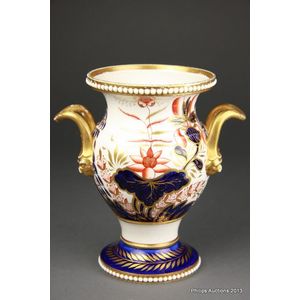Regency Spode Pedestal Vase with Floral Design and Gilding
You must be a subscriber, and be logged in to view price and dealer details.
Subscribe Now to view actual auction price for this item
When you subscribe, you have the option of setting the currency in which to display prices to $Au, $US, $NZ or Stg.
- Regency Period - The Regency period in English furniture design refers to the period when King George III, was declared unfit to rule in 1811, and his son ruled as proxy as Prince Regent, until 1820, and then, after the death of his father as George IV until his death in 1830. The Regency period was preceded by the Georgian period (George I, George II, and George III: 1714 - 1811), and was followed by the William IV period, which only lasted until 1837 when William IV died as was succeeded by Queen Victoria.
- Circa - A Latin term meaning 'about', often used in the antique trade to give an approximate date for the piece, usually considered to be five years on either side of the circa year. Thus, circa 1900 means the piece was made about 1900, probably between 1895 and 1905. The expression is sometimes abbreviated to c.1900.
- Gilding - Gilding is a method of ornamentation whereby a thin sheet of gold metal is applied to items made of wood, leather, ceramics, glass and silver for decorative purposes.
For furniture including mirrors, the sheet of gold is usually applied over a coating of gesso. Gesso is a mixture of plaster of Paris and gypsum mixed with water and then applied to the carved wooden frames of mirrors and picture frames as a base for applying the gold leaf. After numerous coats of gesso have been applied, allowed to dry and then sanded a coat of "bole", a usually red coloured mixture of clay and glue is brushed on and allowed to dry, after which the gold leaf is applied. Over time parts of the gilding will rub off so the base colour can be seen. In water gilding, this was generally a blue colour, while in oil gilding, the under layer was often yellow. In Victorian times, gilders frequently used red as a pigment beneath the gold leaf.
Metal was often gilded by a process known as fire gilding. Gold mixed with mercury was applied and heated, causing the mercury to evaporate, the long-term effect of which was to kill or disable the craftsman or woman from mercury poisoning. The pursuit of beauty has claimed many victims, not the least of which were the artists who made those pieces so highly sought after today.
This item has been included into following indexes:
Visually similar items

A Paris Porcelain urn, 20th century, the trumpet form campana urn with a gadroon rim, rams' head bracket handles and raised upon a spreading socle to a squared base, decorated to shaped reserves with baskets of flowers in coloured enamels upon an apple gre

A Spode white ground pedestal vase, 1822, pattern 3789, the flaring vase with volute handles and rosettes, decorated with a colourful arrangement of summer flowers spilling from a basket, with an additional spray and sprig, pattern number only underside, s

A Spode Imari-manner handled vase, circa 1820, decoration pattern 2214, of baluster form with a pair of mask and loop handles to the sides, decorated in the Imari style and palette with flowering foliage, painted mark and pattern number underside. Height 1

A Victorian Strerling silver pint tankard with chased floral and 'C' scroll decoration marked ACP London 1864 382gm h 14 cm
